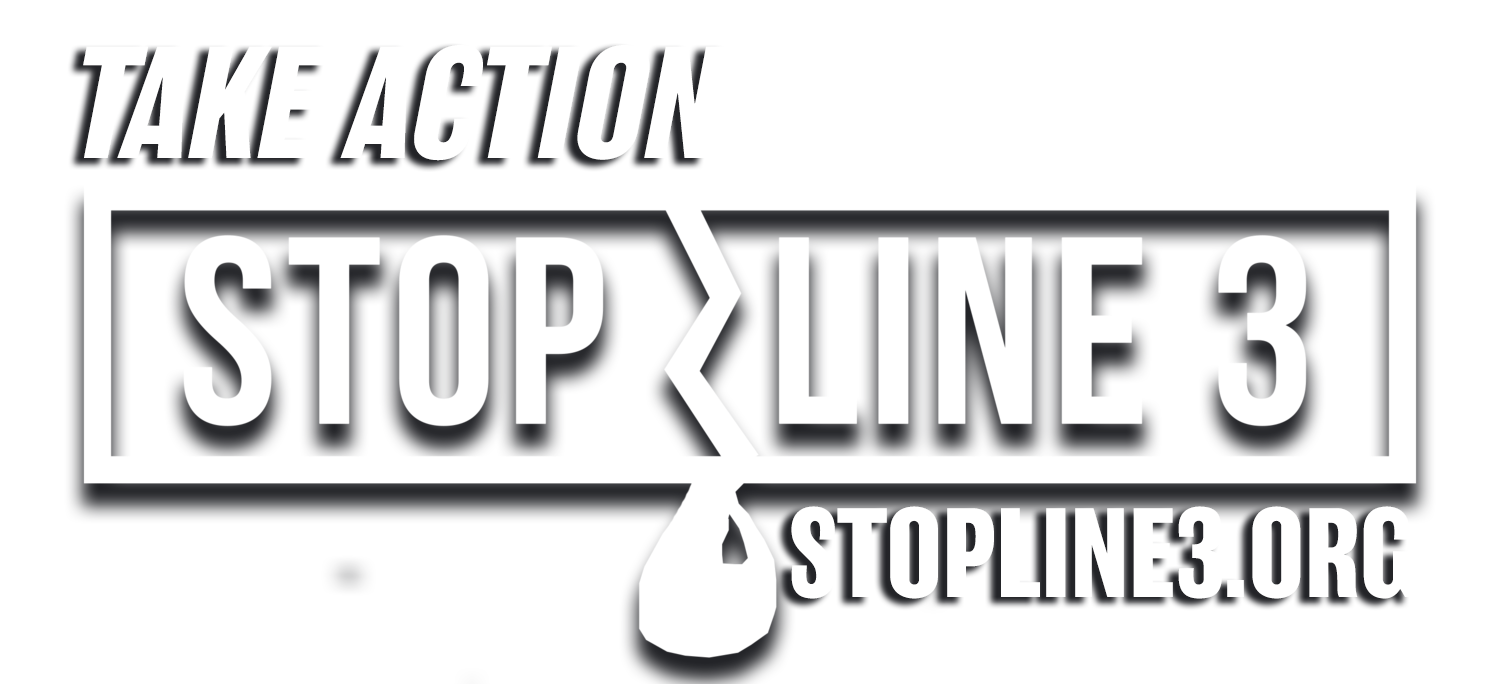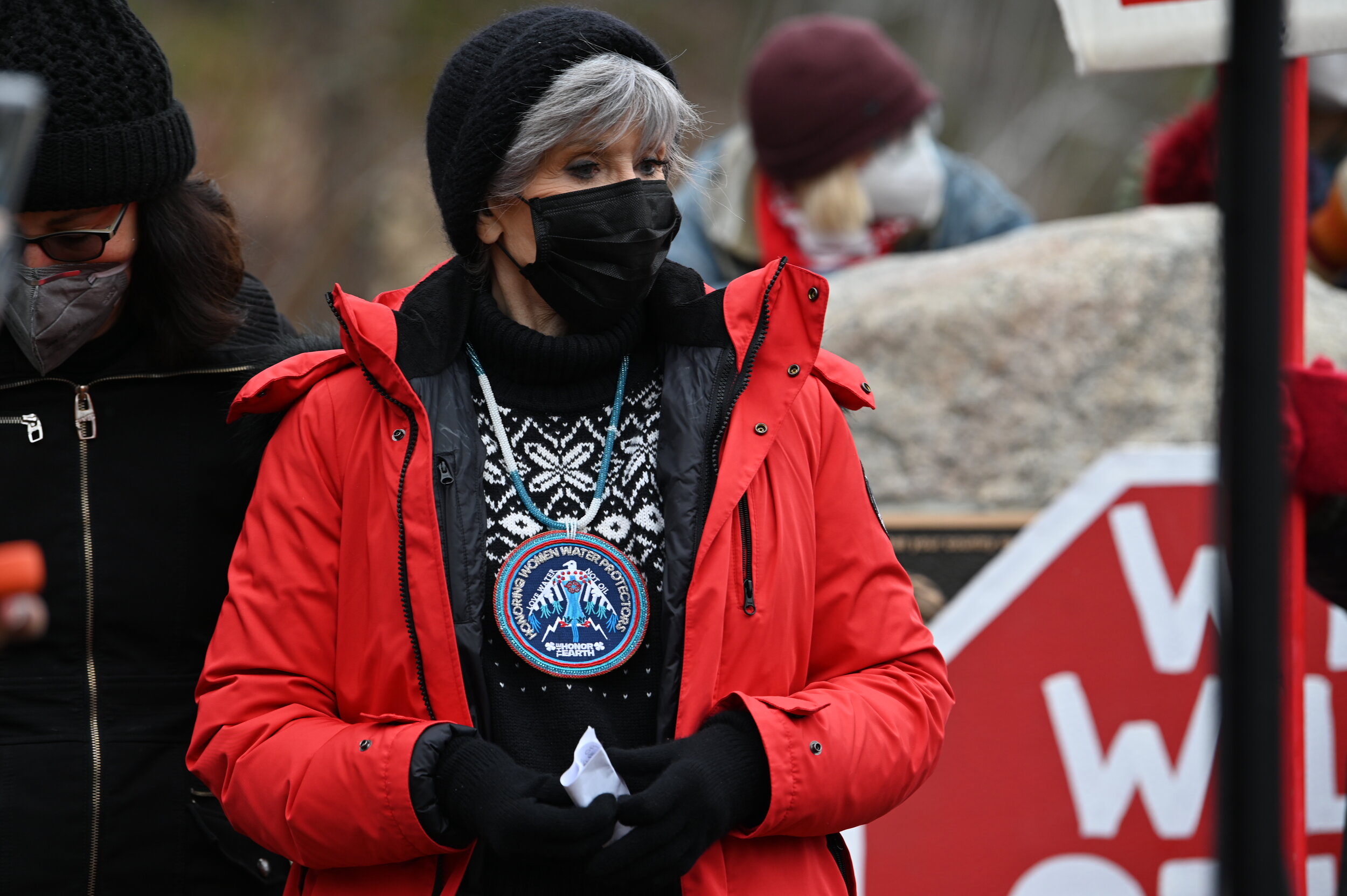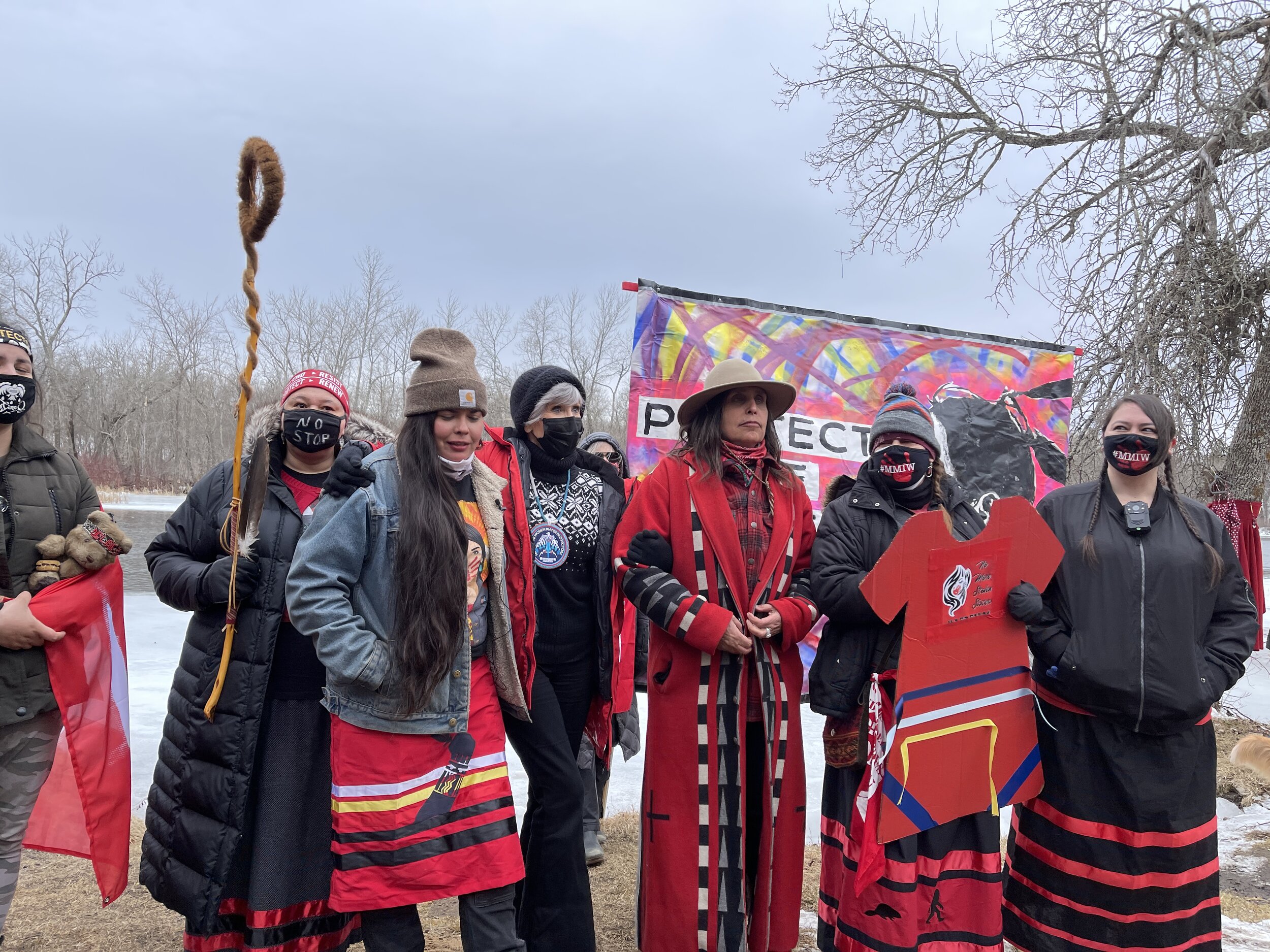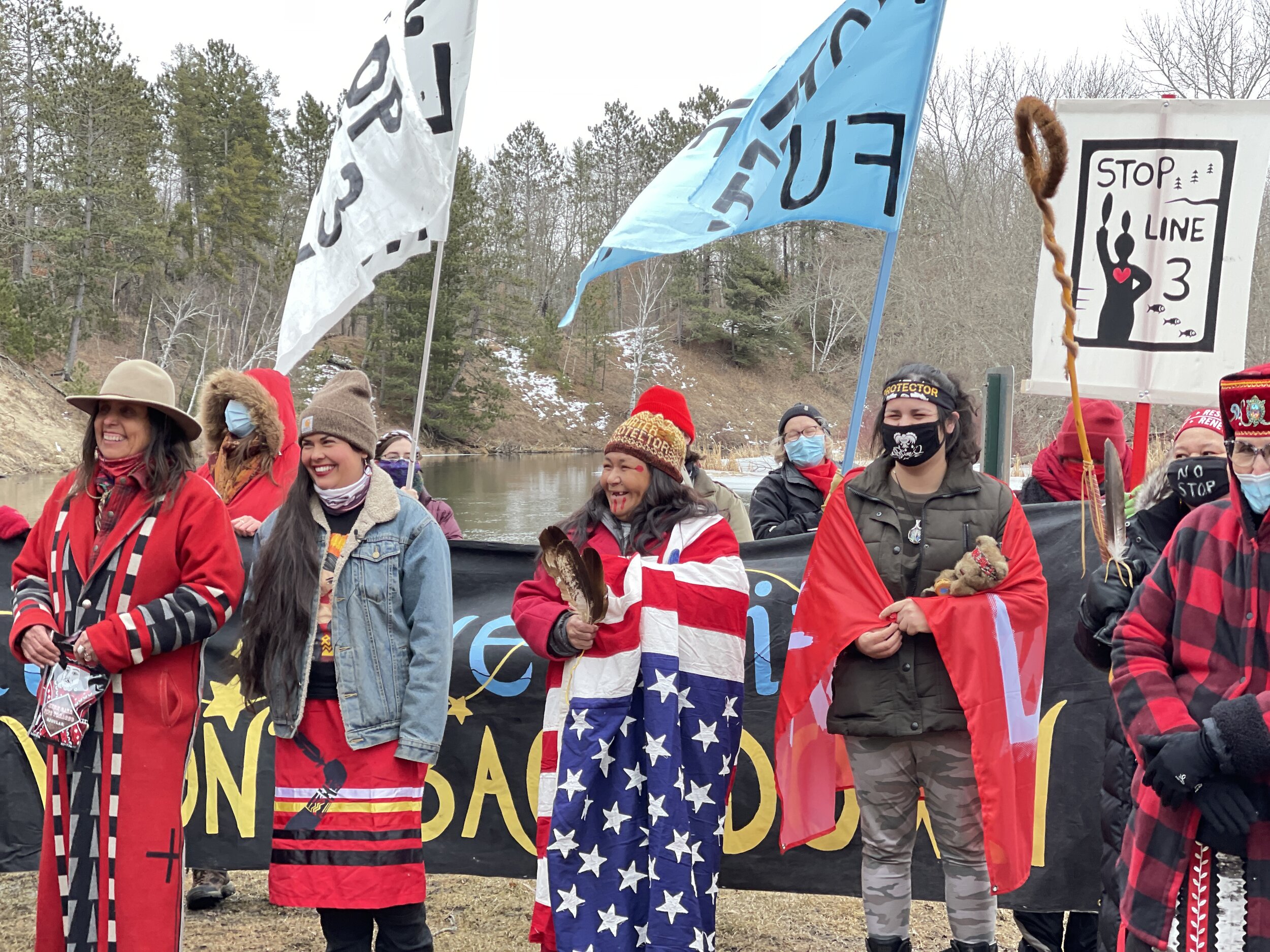Finding Fonda
Tracking down legendary Hollywood activist Jane Fonda as she attempts to help vanquish a new foe in northern Minnesota by Steve Marsh
Photos by Keri Pickett and Sarah LittleRedfeather of Jane Fonda stands with water protectors on the Crow Wing River banks.
It’s mid-March, and Jane Fonda is in northern Minnesota. I see her post on Instagram: Fonda dressed in all black save for a colorful Ojibwe-style beaded necklace, wearing big shades, with her silver fringe peeking out from under a stocking cap. She’s standing next to a NO TRESPASSING sign, and there are huge mounds of rubble behind her, as well as big sections of oil pipeline staged, ready to be put in the ground.
In her video post, she says she’s here to protest Enbridge’s Line 3, a $9 billion replacement pipeline that will sluice through Minnesota’s wilderness for 337 miles, connecting the oil sands region of Alberta and pumping nearly 32 million gallons of tar sands sludge and other crude oils a day to a terminal center in Wisconsin on Lake Superior.
“This is the pipeline that they want to lay under the headwaters of the Mississippi,” she says in the video. “Tar sands oil, the worst! And we’re here to try to stop it!”
I read some comments on her post and discover she’s going to be at a news conference that afternoon with the Ojibwe activist Winona LaDuke on the Crow Wing River—the same river my dad grew up on, a river my wife and I went for a two-day paddle on last summer. Kind of cool, I think, to have Jane Fonda, the star of 9 to 5; Jane Fonda, the famous dissident, in northern Minnesota to protest the oil pipeline being built under my favorite river. I share the video on Instagram, and a few minutes later, my editor in chief shoots me a note:
“Get up there! Interview her!”
Fortuitously, my wife, Maggie, will be heading to Wadena the following morning, as she’s overseeing the opening of a new clay tile manufacturing studio there. Wadena is about an hour south of Park Rapids on Highway 71—close to the Mississippi’s headwaters, the surrounding area of which has been the primary locus for the Indigenous water protector–led Line 3 protests over the winter.
The first person I reach out to is Tara Houska, the Ojibwe tribal attorney I interviewed last summer. Houska is one of the leaders of the Giniw Collective, a resistance camp located outside of Park Rapids. The camp has notoriously bad cell phone reception, however, and unfortunately, my text message to Houska goes unreturned, so I contact my friend Lee Taylor, a New York–based singer-songwriter and activist who works with the Ojibwe elder and playwright Sharon Day. Taylor checks in with Day.
“She said you can go up anytime, especially if you come up to pray—I mean, you already prayed with us, so you probably have more background than most white people going,” Taylor says over text.
I tell her to thank Day for her blessing, but I still have no idea if there will actually be a protest tomorrow.
“Just check Facebook!” she replies. “We don’t care about the man seeing lol.”
There are plenty of places to check: Stop Line 3 has a public group, as do Honor the Earth (LaDuke’s organization) and the Giniw Collective, among many others. But before I even wade into those waters, I get a tip from Twin Cities activist Marian Moore that yes, there will be direct action the next day at the Highway 40 Mississippi River bridge at 11:30. As far as she knows, Fonda will still be around. Moore gives me the contact information for Fonda’s press coordinator, Tessa, to make my interview request.
•••••
The next morning, after dropping Maggie off in Wadena, I continue north on 71 until I run into the Mississippi. I find the bridge. There are about a dozen cars lining the road, and after parking mine, I walk toward the banks to join a circle of about 35 people, probably 80 percent women, all watching three Native men singing and keeping an insistent rhythm on hand drums. Everybody’s attention is drawn to three gigantic two-person puppets: a 10-foot-tall Native woman alongside one black bear and one timber wolf. They’re each big enough that they require two-person teams to operate.
“Winona is in the bear,” the Native woman next to me says.
Is Jane Fonda in the wolf?
One of the leaders announces plans to walk across the highway and gather by the Enbridge service road for a prayer.
I look at the Mississippi, actually flowing north through smushed-down yellow wetland grasses that are beginning to thaw. It’s so shockingly small when you encounter it up near the headwaters—just a cute little baby river. I feel a paternal twang toward the scrawny young river. I just want the little guy to succeed and grow up to be the country-bisecting behemoth that eventually rolls into the Gulf of Mexico.
(We are Water Protectors Not Protestors)
One of the protesters , a middle-aged woman named Jami, says she started coming to these protests because she only lives a couple miles away, and the more she learned about the pipeline, the angrier she got. She points out where the pipeline will snake under the river.
“And it’s not just oil that will be sent through it,” she says. “If an oil pipeline breaks, the oil will float to the top of the water, but this tar sands is more like a peanut butter sludge, and if it breaks—which it will—that sludge will sink to the bottom, as the benzenes they use to keep it broken up and flowing will evaporate into the air.”
She tells me that according to analysis by Honor the Earth, Enbridge is actually the largest consumer of electricity in the state of Minnesota.
“Need a lot of power to push that shit through the pipeline,” she says.
(In response, Enbridge’s spokesperson says it is not the largest energy consumer in the state and “Line 3 will carry primarily light crude.”)
Winona LaDuke’s documentarian Keri Pickett films the whole group as they walk en masse past a Clearwater County sheriff’s deputy standing outside of his SUV to the service road Enbridge is building. There is another lady peering out of a big Ram pickup truck. People tell me she’s working as Enbridge security today, keeping watch. I stand next to a first-grade teacher from the Cities who’s up here protesting on spring break. A Native woman holding an eagle wing tells us to set an intention and to make some noise as our prayer. The black bear puppet growls, and the wolf puppet howls.
After the puppet costumes are placed in the back of a U-Haul truck, there on the side of the road stands Winona LaDuke herself. She’s wearing a dirty red parka with a “water protector” patch on the sleeve and her wool cap turned backward on her head, a little sweaty from being in the bear suit. Now 61, she’s been living in the White Earth resistance camp a few miles away, still championing the environment she grew up with. I get out my tape recorder and walk over.
“I’ve spent my whole life fighting dumb ideas,” she says, “from coal plants to mega dams to genetically modified wild rice. But this new tar sands mega-pipeline might be the dumbest.”
She says she’s been harassed by the cops and arrested six times already for protesting Line 3 on charges like unlawful assembly and “trespassing on critical infrastructure.”
“That’s the new terrorist charge,” she says, rolling her eyes.
She knows the ultimate reason behind this latest dumb idea—“Enbridge’s money poisons everything”—but she doesn’t understand why so many people who should know better are on board. According to LaDuke, oil pipelines don’t make sense anymore, economically or ecologically.
“It’s such a bitter pill for our tribes,” she says. “This is Walz’s equivalent to the wall: an infrastructure project that is not needed.”
(Enbridge says it has “demonstrated ongoing respect for tribal sovereignty and the project is already providing significant economic benefits.”)
I ask her why there aren’t more people up here if it’s such an obviously dumb idea, and if the lack of enthusiasm connotes that it’s a lost cause at this point. Her piercing green eyes turn steely.
“We’re way before halftime,” she says.
She says the project is 50 percent in the ground, but Enbridge will have to go on hiatus while the roads dry out from the thaw, maybe until May. “And if we can get 150 people up here when it’s 10 below, what do you think will happen when it’s 70 degrees out?”
I ask her what she thinks about Jane Fonda.
“I mean, I’ve never been much of a—what do you call it?—like a Hollywood fan person,” she says. “But if you got that damn much influence, you should use it for something good.”
Her press person says she has another commitment, and as she walks away, she turns back.
“Jane Fonda and Jason Momoa,” she quips. “Those are my two favorites.”








